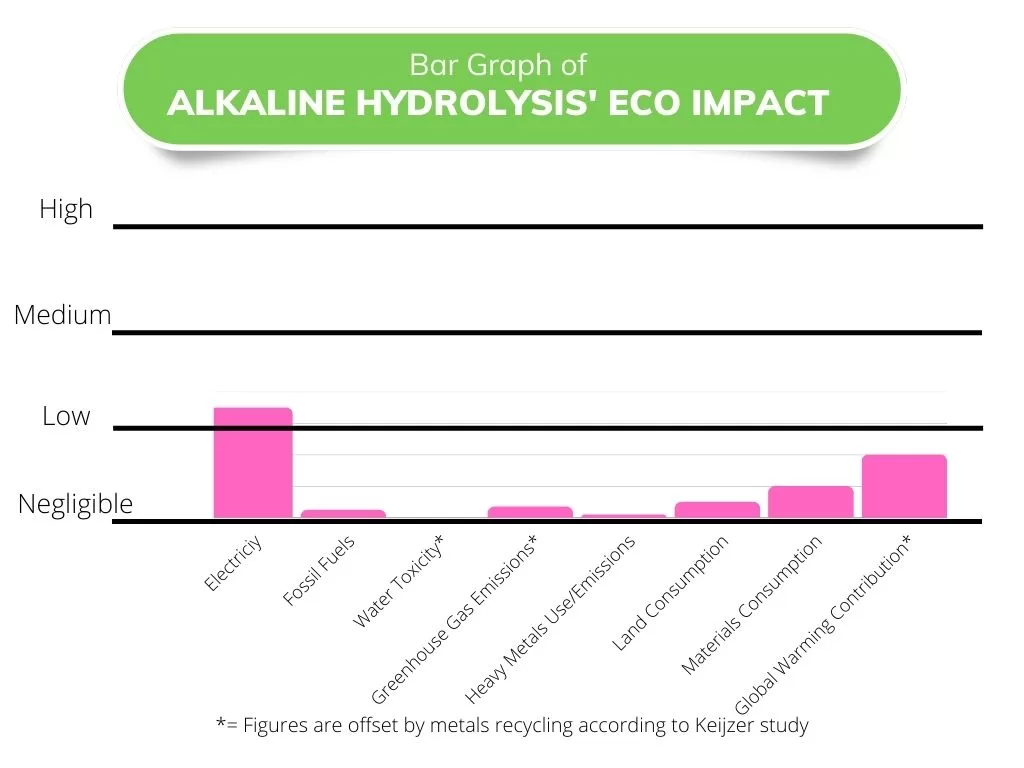Alkaline Hydrolysis, also known as water cremation, is an extremely eco-friendly disposition method with little impact on the environment. Understanding the environmental impact of alkaline hydrolysis can help you make more eco-friendly funeral choices for yourself and your family.
Aquamation, one of the leading companies to offer alkaline hydrolysis in the US, explains the process with the following steps, ““With Aquamation, an individual body is respectfully placed in a container that is then placed in a clean, stainless steel vessel. A combination of gentle water flow, temperature, and alkalinity are used to accelerate the natural process of tissue hydrolysis. All organic material is reduced to its most basic building blocks. At the end of the process, there is no DNA or RNA remaining. The sterile process water is released for recycling (our bodies are approximately 65% water to begin with), and only the inorganic bone minerals remain.”
According to research by Aquamation, alkaline hydrolysis offers over 90% energy savings when compared to flame-based cremation.
The most common question about the environmental impact of alkaline hydrolysis is around the recycling of the fluid left behind by the process. Aquamation explains that, “The water-based process uses a solution of 95% water and 5% alkali (a combination of sodium and potassium hydroxide). The alkalis used in this process are the same alkalis used in biodiesel p in biodiesel production, common cosmetic products, body washes, shaving creams, and even in food preparation. At the end of the process, the chemical has been completely consumed, neutralized, and no longer remains in the water solution. The water is returned to the ecosystem via the normal wastewater treatment facility, just as all funeral homes in the United States do during the embalming process. The Aquamation process produces a completely sterile solution of amino acids, sugars, nutrients, salts, and soap in a water solution. These are the byproducts of natural decomposition.”

Research and Data: The Environmental Impact of Alkaline Hydrolysis
The “90% energy savings” as cited by Aquamation is based on research performed by a team of scientists and researchers in the Netherlands conducting a study comparing the environmental impact of four disposition methods (traditional burial, cremation, alkaline hydrolysis, and cryomation. The study researched 10 areas of impact including acidification, global warming contribution, ozone depletion, freshwater ecotoxicity, terrestrial ecotoxicity, among others.
Research found that, of those four disposition methods, the environmental impact of alkaline hydrolysis was the lowest overall. In fact, Alkaline Hydrolysis was lowest in every category except for eutrophication, or putting high amounts of nutrients into the environment. Water cremation uses fewer resources and less energy than the other methods, and offers much of the exact same energy usage offsets provided by metals recycling that we saw with flame cremation. The study concludes that “Cryomation and resomation have the lowest environmental impact in all categories, except for eutrophication.” To learn more about the environmental impact of alkaline hydrolysis when compared to other funeral options, download our free ebook “The Real Eco-Impact of Disposition”
Alkaline Hydrolysis and Metals Recycling Offsets
Even though green burial technically uses the least amount of energy as far as electricity goes, and NOR uses the least fossil fuels, the reclamation of metals from bodies that undergo alkaline hydrolysis more than offsets this energy gap. This process greatly reduces the environmental impact of alkaline hydrolysis.
While alkaline hydrolysis is already inherently low in energy use, pollution, and global warming contribution, metals recycling means that a big portion of the small emissions and energy usage that is produced with alkaline hydrolysis can also be offset, lowering the method’s overall environmental impact significantly. In fact, according to the Netherlands study, metals recycling can even make alkaline hydrolysis have a net positive eco-impact in some areas.

Information gathered from Aquamation’s environmental impact research states that, “The ability to recycle metals provides an enormous environmental benefit. In fact, a 2011 study on the impact of funeral practices (Keijzer 1, 2) found that alkaline hydrolysis is more environmentally friendly than even natural burial. Even though green burial directly uses the least amount of energy, the reclamation of metals from bodies that undergo alkaline hydrolysis more than offsets this energy gap.”
There are other heavy metals that need to be recycled from human remains, and research from Aquamation elaborates, “We can look to the types of metals used for implants and how they are made to understand the environmental credit of the recycling. Most medical implants are made of titanium. While titanium is the ninth most abundant element on Earth, its acquisition comes with a steep environmental cost. The cost to obtain and transport the materials used to make titanium – often from other countries – is one aspect, while the actual process to turn it into usable products is another (extraction, purification, reactor, alloy creation, and byproduct management). According to the United States Geological Survey, the US has become highly dependent on the import of materials used to make titanium. A 2017 Italian study (De Angelis, et al.) found that the average person contains one half pound of metal from implants. Metal implants are even more common in the United States and Canada”
The metals recycling that is possible when families choose alkaline hydrolysis offers a huge benefit to the environment by recirculating metals that we already have access to back into the market, which lowers the need for more mining and new metals acquisition.
The Environmental Alkaline Hydrolysis: A Nearly Net-Zero Impact
The article “Dissolving the Dead: A Radical Alternative to Cremationand Burial” from BBC breaks down the findings of Dutch researcher, Elizabeth Keijzer, from a study comparing the eco impact of disposition methods in the UK. The study found that alkaline hydrolysis was the least environmentally impactful disposition method available to date. The BBC article explains,
“According to Dutch researcher Elisabeth Keijzer, who has carried out two studies for the Netherlands Organisation for Applied Research (work commissioned by a funeral chain, Yarden), [alkaline hydrolysis] is much better. Her two reports published in 2011 and 2014 make for fascinating if macabre reading. She breaks down burial, cremation and alkaline hydrolysis into dozens of steps, which she assesses against 18 environmental impact yardsticks – such as ozone depletion, marine eco-toxicity and climate change. In 17 of these categories alkaline hydrolysis comes out best. Cremation is worst in the most categories (10), but burial is deemed to have the highest overall environmental impact. Alkaline hydrolysis is found to result in the emission of seven times less CO2 than cremation. To summarize the results, Keijzer and her fellow researchers calculated a “shadow price” for each method – the lowest amount of money it would theoretically cost to either compensate for the environmental impact, or avert it. For burial, the net cost was 63.66 euros per body. For cremation, it was 48.47 euros. For alkaline hydrolysis, just 2.59 euros.”

Overall, the environmental impact of alkaline hydrolysis is extremely low. Alkaline hydrolysis a safe, respectful method of disposition that has virtually no impact on the environment. The water returned to wastewater treatment facilities is a completely sterile solution of amino acids, sugars, nutrients, salts, and soap in a water solution. This is comparable to all of the fluids and body materials flushed into water systems by all funeral homes in the United States during the embalming process. Alkaline hydrolysis machines like the ones available from Resomation, and the cremulators used to pulverize bones after the alkaline hydrolysis process use very little electricity. Furthermore, metals recycling often more than offsets the minimal environmental impact that alkaline hydrolysis has.
The Future of Alkaline Hydrolysis
As more people in the US are seeking out eco-friendly disposition methods and funeral practices, it stands to reason that aquamation will continue to grow in popularity. Another article from Choice Mutual outlines how funeral practices have changed in the US just since the onset of the Covid-19 pandemic, and reveals that younger generations are more educated about and aware of alkaline hydrolysis. This data suggests that alkaline hydrolysis will only continue to grow in popularity in the coming years. For funeral businesses, this means that figuring out how to incorporate alkaline hydrolysis into business strategies for the future will most likely be a lucrative investment of time, energy, and money.
To learn more specifics about how the environmental impact of alkaline hydrolysis stacks up to the other disposition methods, what states alkaline hydrolysis is currently available in, and how to offer it to your families in the future, click below to download the full ebook guide “The Real Eco-Impact of Disposition Methods”



